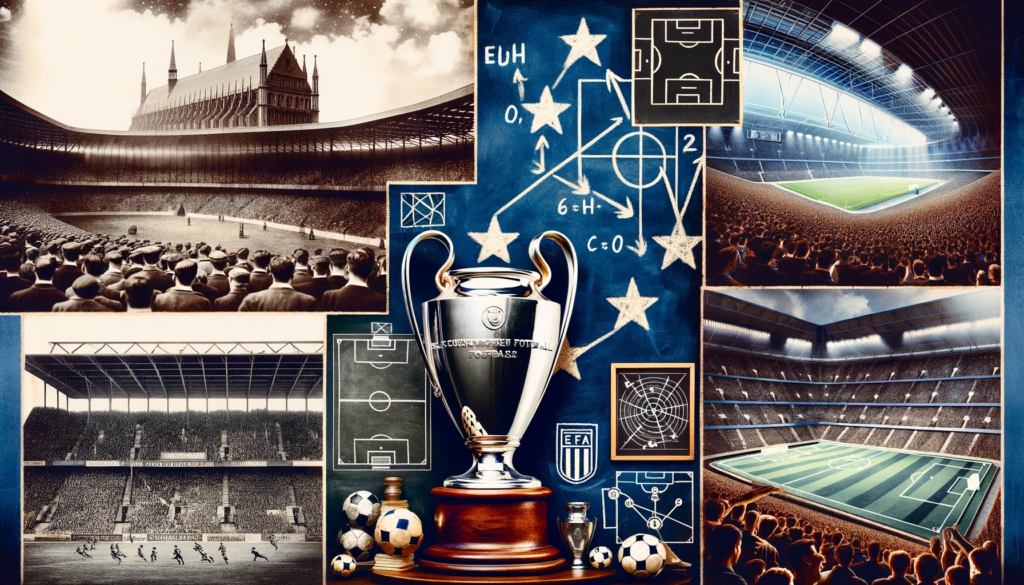European football, often known as soccer, is a tapestry rich with competitions, governed by intricate rules, and shaped by evolving tactics throughout its storied history. The game is more than a sport on the continent; it’s a cultural phenomenon that brings together nations, communities, and individuals.
From the adrenaline-fueled competitions that crown the kings of Europe to the tactical masterstrokes that define the modern game, soccer is a realm of passion and precision. The history of European football is a chronicle of change, where the past informs the present and shapes the future.

What Are the Major European Football Competitions?
European football hosts some of the most prestigious competitions in the world, with the UEFA Champions League standing as the pinnacle for club football. This annual tournament sees Europe’s top football clubs compete for the coveted title of continental champions. Similarly, the UEFA Europa League offers a platform for clubs from across Europe to showcase their prowess.
National teams vie for glory in the UEFA European Championship, commonly known as the Euros, held every four years. For the younger talents, the UEFA European Under-21 Championship is a proving ground.
How Is the Champions League Structured?
The Champions League begins with a series of qualifying rounds, followed by a group stage, and culminating in knockout rounds that lead to the final. According to UEFA.com, the group stage comprises 32 teams split into eight groups of four, with the top two from each group advancing to the round of 16. The drama of the knockout stages unfolds in two-legged ties, except for the final, which is a single-match decider.
What Role Does the Europa League Play?
The Europa League is seen as the second tier of European club competitions but is prestigious in its own right. It offers a chance for a wider range of clubs to compete in Europe. The competition includes a group stage and knockout rounds, with an interesting twist: third-placed teams from the Champions League group stage drop into the Europa League knockout rounds, adding a layer of unpredictability and excitement to the tournament.
What Makes the Euros Special?
The European Championship (or simply the Euros) is a festival of national pride and footballing skill. It is notable for its intense format and the fact that it often produces unexpected heroes and storylines. For many nations, the Euros are a rare opportunity to compete at the highest level, and for fans, it’s a chance to see a wide array of European talent on one stage.
What Are the Fundamental Rules of European Football?
The rules of European football, known as the Laws of the Game, are maintained by the International Football Association Board (IFAB) and are applied universally across the sport. These laws cover everything from the size of the pitch to the intricacies of offside rules.
What Is the Offside Rule?
The offside rule is one of the most discussed aspects of football. A player is considered offside if they are nearer to the opponent’s goal line than both the ball and the second-last opponent when the ball is played to them, with some exceptions. This rule prevents players from simply waiting near the opponent’s goal for a pass.
How Are Fouls and Misconduct Managed?
Fouls are penalized with free kicks or penalty kicks, while misconduct can lead to cautionary yellow cards or expulsionary red cards. The Laws of the Game also outline the procedures for video assistant referee (VAR) systems, now widely used to review decisions by the on-field referee.
What Changes Have Been Made Recently?
In recent years, IFAB has introduced several changes to modernize the game. For instance, goalkeepers must now have only one foot on the line during penalty kicks, and players can be substituted out at the nearest point on the boundary lines to speed up play.
How Have Tactics Evolved in European Football?
European football has always been a hotbed of tactical innovation. From the early days of rigid formations to the fluid systems of the modern era, the continent has led the way in strategic thinking on the pitch.
What Was the Catenaccio?
The Catenaccio, or “door-bolt” in Italian, was a tactical system with a strong emphasis on defense. It originated in Italy in the 1960s and was characterized by a highly structured formation focused on nullifying opponents’ attacks, often leading to counter-attacking football.
What Are the Current Tactical Football Trends?
Modern European football tactics emphasize high pressing, possession, and quick transitions. Teams like FC Barcelona and Manchester City have epitomized the possession-based approach, while others, such as Liverpool, have been successful with high-energy pressing and rapid counter-attacks.
How Did Total Football Change the Game?
Total Football, developed by the Dutch in the 1970s, revolutionized tactics with its fluid system where any player could take over the role of any other player on the pitch. It emphasized universal skills and positional interchange, laying the groundwork for modern dynamic systems.
Common Professional Football Injuries
Professional football is a physically demanding sport that often leads to a range of injuries. These injuries vary in severity and recovery time.
A comprehensive list of injuries in professional football includes.
- Strains and sprains, affecting muscles and ligaments, especially in the legs.
- Fractures, often occurring in the legs and feet from direct impacts (e.g., tackles) or repetitive stress (e.g., running).
- Concussions, resulting from blows to the head, leading to temporary loss of brain function.
- Knee injuries, including ACL tears, caused by high-intensity running and sudden changes in direction.
- Groin injuries, due to extensive use of hip muscles, often requiring a lengthy recovery period.
Head injuries, including concussions, are also a significant concern, with potential immediate and long-term health implications. Professional footballers are more likely to suffer neurological diseases due to repeated head impacts
What Is the History of European Football?
Football’s roots in Europe can be traced back over a century, with the formation of the English Football League in 1888 being a seminal moment. The sport quickly spread across the continent, becoming an integral part of the cultural fabric in countries such as Italy, Germany, and Spain.
How Did the World Wars Affect European Football?
The World Wars brought widespread interruption to football, but the post-war period saw a resurgence in the game’s popularity. Clubs and national teams became symbols of recovery and unity, with tournaments like the World Cup and the Euros serving to heal post-war divisions.
What Are Key Moments in European Football History?
Moments like the Heysel Stadium disaster in 1985, where 39 people died due to a wall collapse, led to English clubs being banned from European competitions for five years, influencing significant improvements in stadium safety. The Bosman ruling in 1995 changed the transfer system, allowing free movement of players within the EU.
